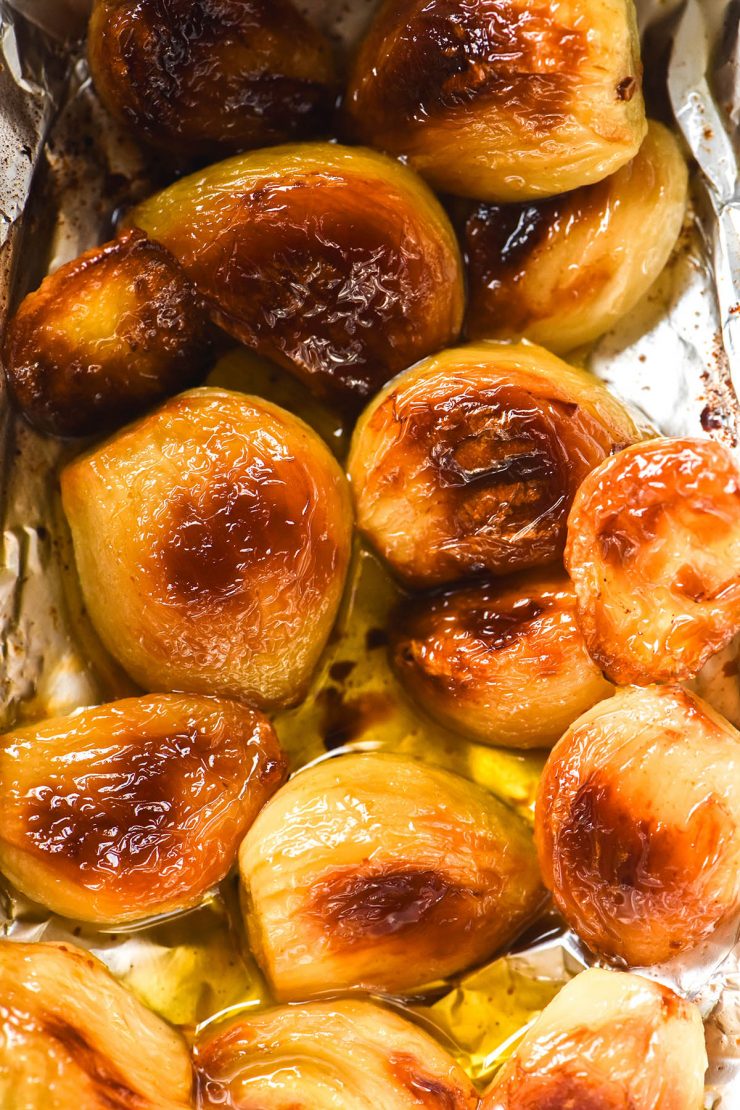
Before you click on this with the intention of telling me off: yes, this is roasted garlic and it is also low FODMAP. But how, you ask? Through the magic of pickling. After Monash recently introduced a low FODMAP threshold for pickled garlic, I knew I had to develop a recipe. After I developed said recipe, I wondered: would pickled garlic roast? The answer is a resounding yes, so today we’re making low FODMAP roasted garlic.

Low FODMAP roasted garlic
As we have discussed, this recipe uses pickled garlic which is roasted after pickling. I highly recommend making your own pickled garlic – the flavour is incredible and store bought varieties just can’t compete (it’s not even a competition).
I make my own pickled garlic with very simple ingredients – no herbs or fancy flavour additions. This is because I pickle it with the intention of using it as I would regular garlic (if my digestion wasn’t permanently out of office). The delicious garlic flavour shines through without any distractions.
Roasting pickled garlic is as simple as roasting regular garlic. The rinsed and dried garlic cloves are wrapped in foil with a bit of oil and salt. Into the oven they go until the cloves are golden brown and soft. That’s it! Heavenly, incredible and low FODMAP roasted garlic.
An added bonus? Pickled garlic (and thus, pickled roasted garlic) doesn’t seem to give you garlic breath the way regular garlic does. The day I ate 5 cloves, my breath didn’t smell! (of garlic, anyway). A win win situation!
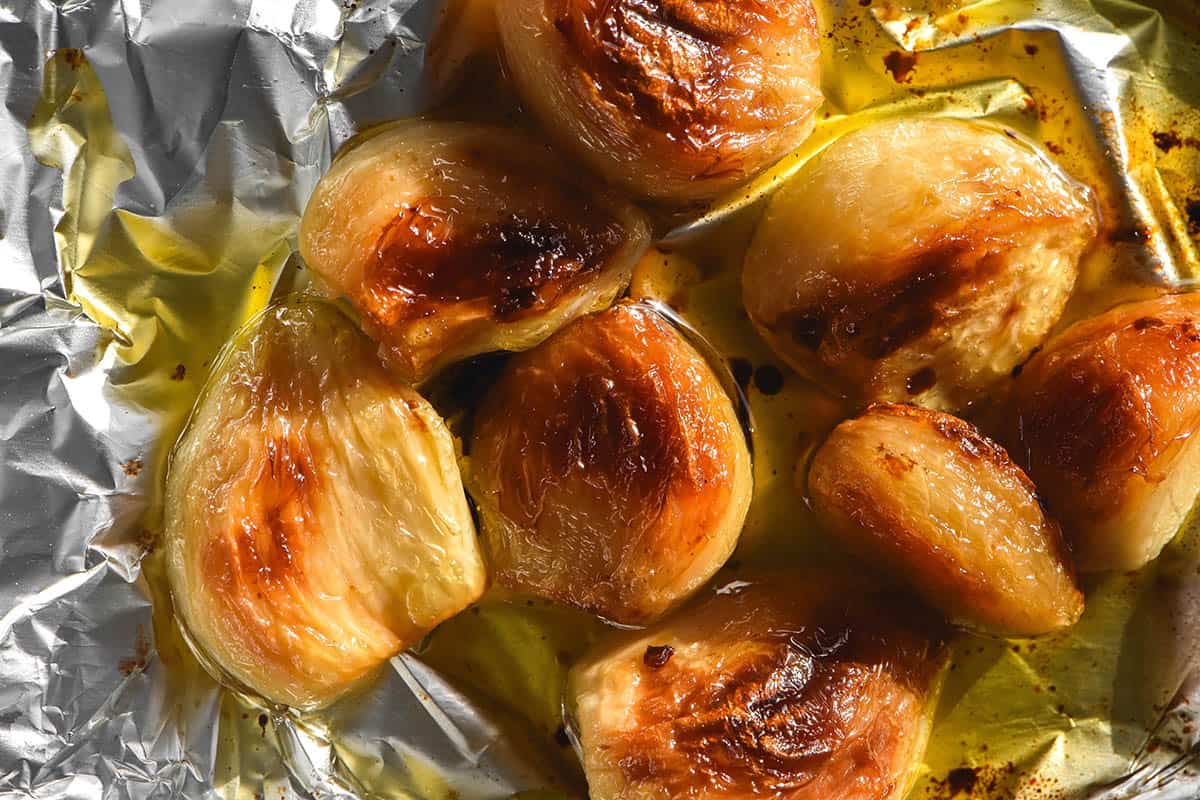
FODMAP notes
If you missed the memo, Monash recently added a low FODMAP threshold for pickled garlic. It is low FODMAP in 3g serves (approximately 1 clove) and in serves of up to 30g (10 cloves).
Monash hasn’t specified whether pickled garlic is low FODMAP the next day, after 2 weeks (the standard pickling time) or something in between. I tested a garlic clove the day after pickling and found I could eat it without issue (amazing!) but you might be different.
As with anything FODMAP, assess your own tolerance and find what works for you.
A fact I find so interesting is that fresh garlic is a fructan containing ingredient. Pickled garlic, in moderate to high servings, is a fructose containing ingredient. The magic of pickling!
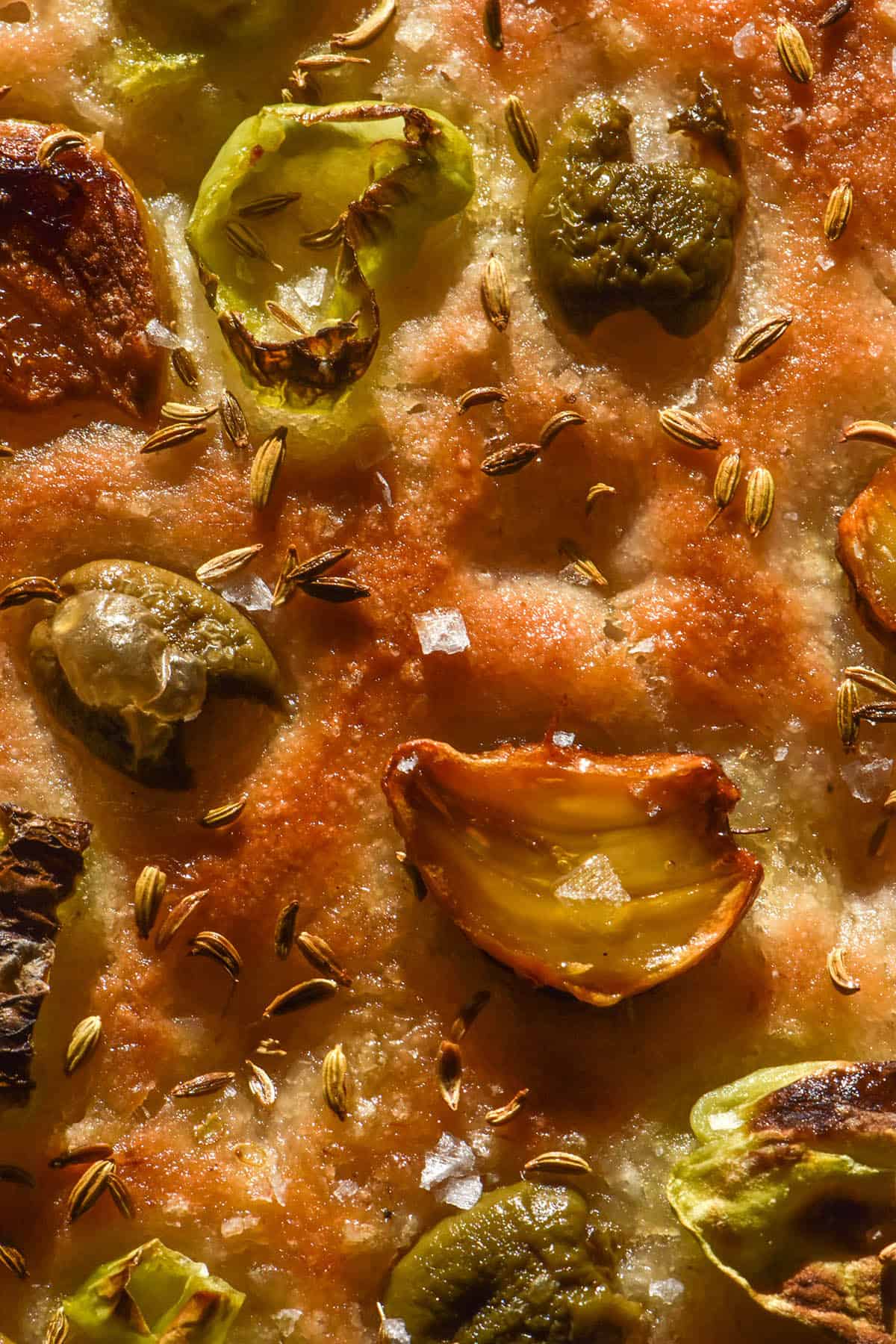
How much pickled garlic can I eat?
That depends! Monash has left a low FODMAP serving size open to the individual. You might be able to tolerate the full 29g (just under the 30g serve) or you might only be able to tolerate 3g. There are some people with FODMAP constraints who have no issues with garlic at all!
Personally, I managed around 5 cloves (I didn’t weigh them) before I felt the pinch. It’s incredibly hard to restrain yourself when you can eat garlic without issue (which then defeats the purpose, but I digress).
I can almost guarantee that if you love garlic but struggle with it, pickled garlic will become a staple in your household. Over time, you will be able to hone in on your individual tolerance for it.
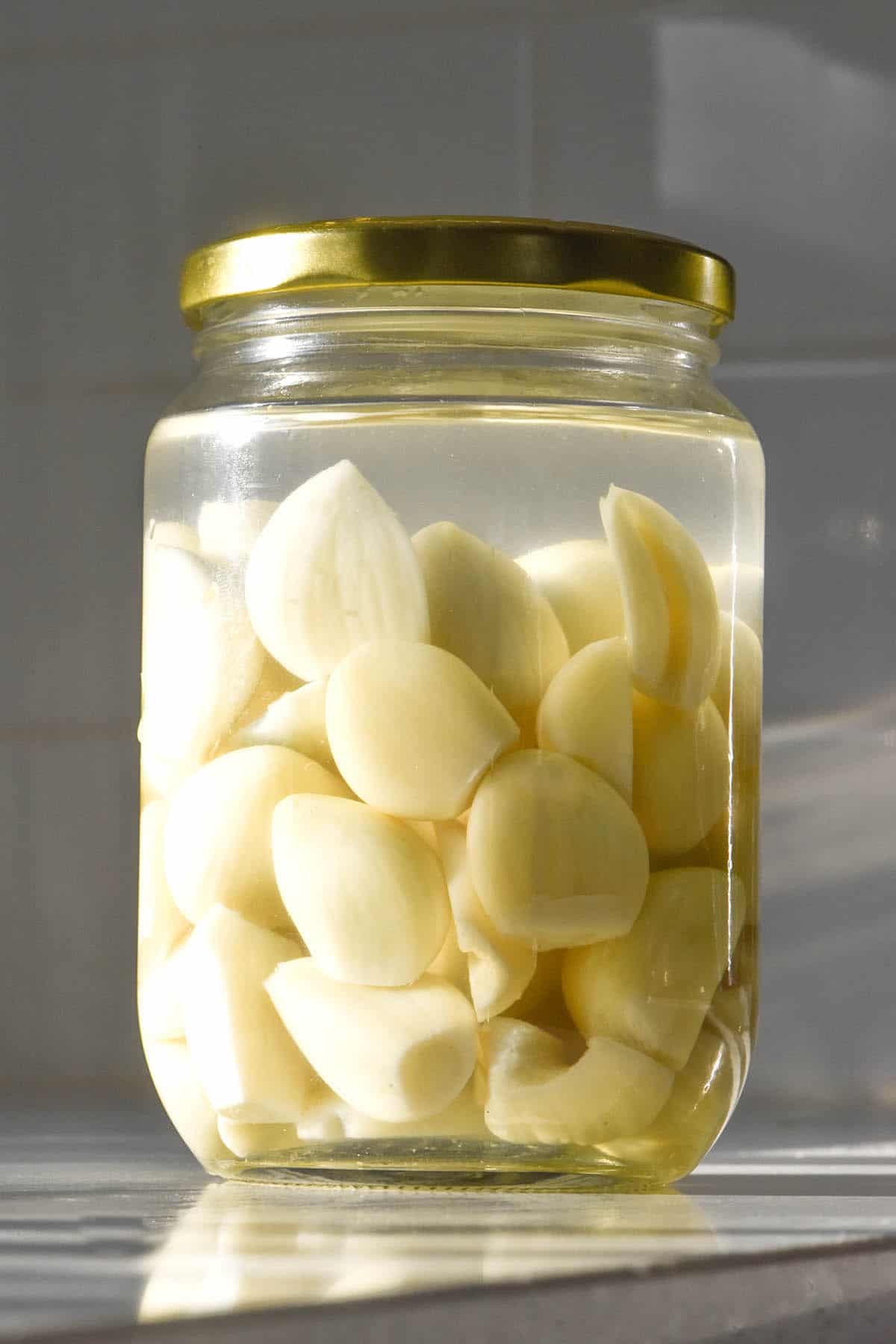
Pickled garlic food safety
A quick note on food safety when it comes to pickled garlic, as there are a few considerations.
- Make sure you follow a recipe to the T, including sterilising your jar and using the right proportion and type of vinegar in your pickle. Garlic is known for developing botulism, which can be fatal. While pickled garlic is safer than garlic oil (as botulism cannot grow in acidic enviroments) you need to be mindful and food safe.
- With this in mind, pickled garlic is not suitable for canning. It needs to be kept in the refrigerator at all times – not kept on a shelf or on the bench. The recipe for pickled garlic is specifically a fridge pickle recipe.
- Use your pickled garlic within around 2 months.
- If you see any mould, unusual sights or smells – throw it out.
- Use a clean spoon to retrieve cloves or pickled garlic. Don’t use grubby hands or grubby utensils. Basic food safety stuff, no?
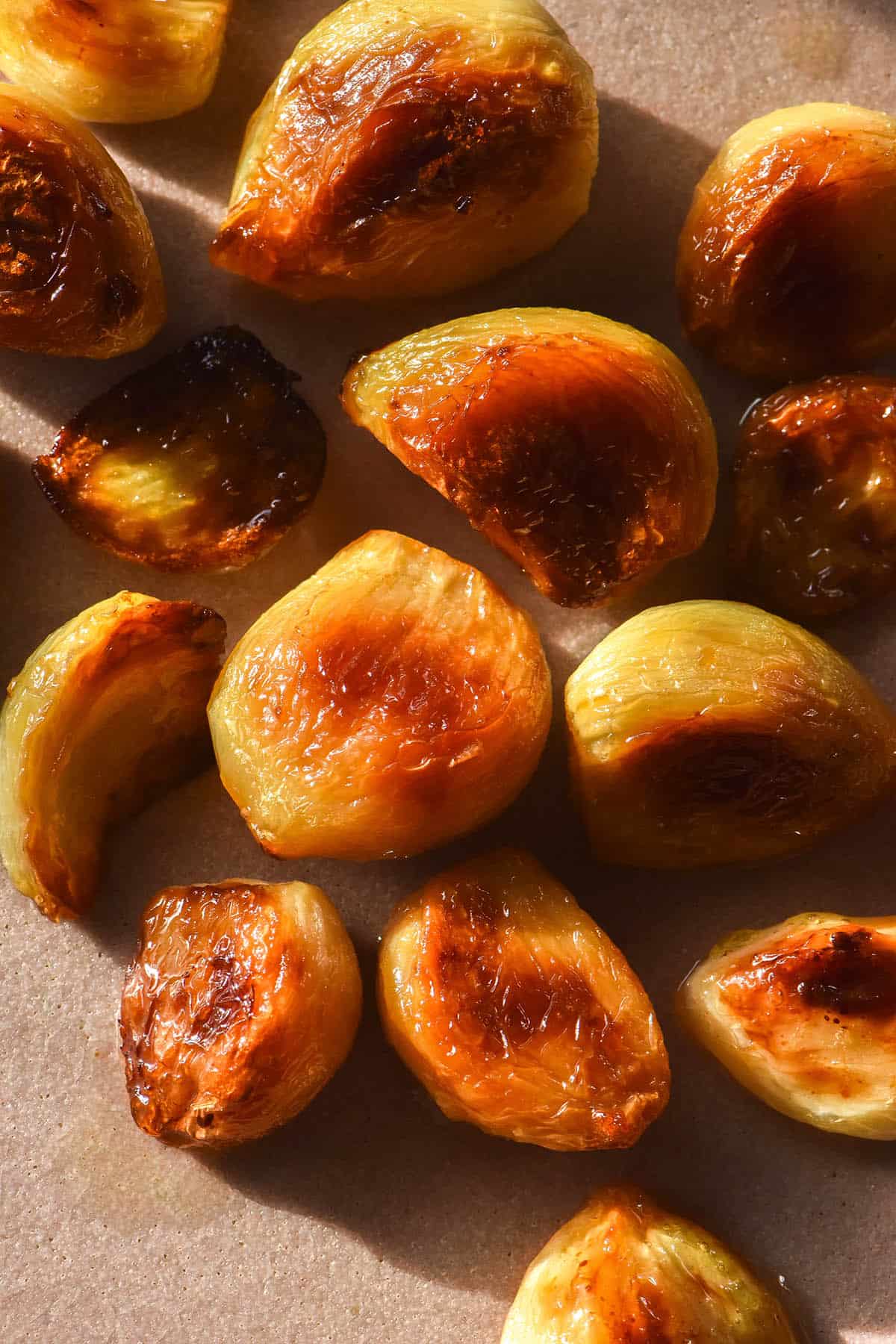
Tips for your low FODMAP roasted garlic
Once you have your pickled garlic, this is a very easy recipe. Simply wrap the garlic up with enough oil to caramelise it and you’re good to go!
I recommend rinsing the garlic cloves prior to roasting them. Monash theorises that pickled garlic is low FODMAP because the FODMAPs leech out into the pickling brine. This is the same as canned beans – the FODMAPs leech into the brine.
Monash instructs us to rinse canned beans, so I theorise that it would be the same with pickled garlic.
More than that, though, I don’t want my roasted garlic to be super acidic and pickle-like. My end goal is to have roasted garlic that tastes pretty much like normal roasted garlic. Giving the cloves a rinse removes some of the excess brine and thus acidity.
You can roast this garlic for as long as you like. You can also roast it in a small dish alongside other things you are cooking (savoury, for obvious reasons).
I recommend arranging the garlic cloves flat on the foil and then wrapping up them like a present. Because our cloves are already separate, we don’t have to wrap them like a head of garlic (as the normies do). Arranging the garlic cloves flat allows them to get an equal amount of heat and thus cook more evenly.
I also recommend placing your parcel(s) of wrapped garlic on a baking dish. Oil seems to slip out of the parcel quite easily and there is nothing worse than an oil smoke oven (my eyes sting at the thought!).
If you’d like your garlic pieces to be evenly browned on either side, gently (without ripping the foil) open the package and flip the garlic pieces half way through baking.

How long does this low FODMAP roasted garlic last?
Regular roasted garlic lasts 2 weeks in the fridge in an airtight container. I don’t know if pickling extends this lifespan, but I would always recommend erring on the side of caution. As such, I recommend keeping this roasted garlic for maximum 2 weeks in the fridge, always in the fridge! Homemade prepared garlic is just not something to mess with.
With that said, you can also freeze the roasted garlic in an airtight container. This is a great option to have roasted garlic on hand to add to dishes on a whim.
The bonus of having to pickle and then roast the garlic is that the roasted garlic cloves remain whole. If you intend to freeze it, I recommend keeping the cloves whole. That way you can grab a few rather than needing to defrost a whole slab of roasted garlic paste.
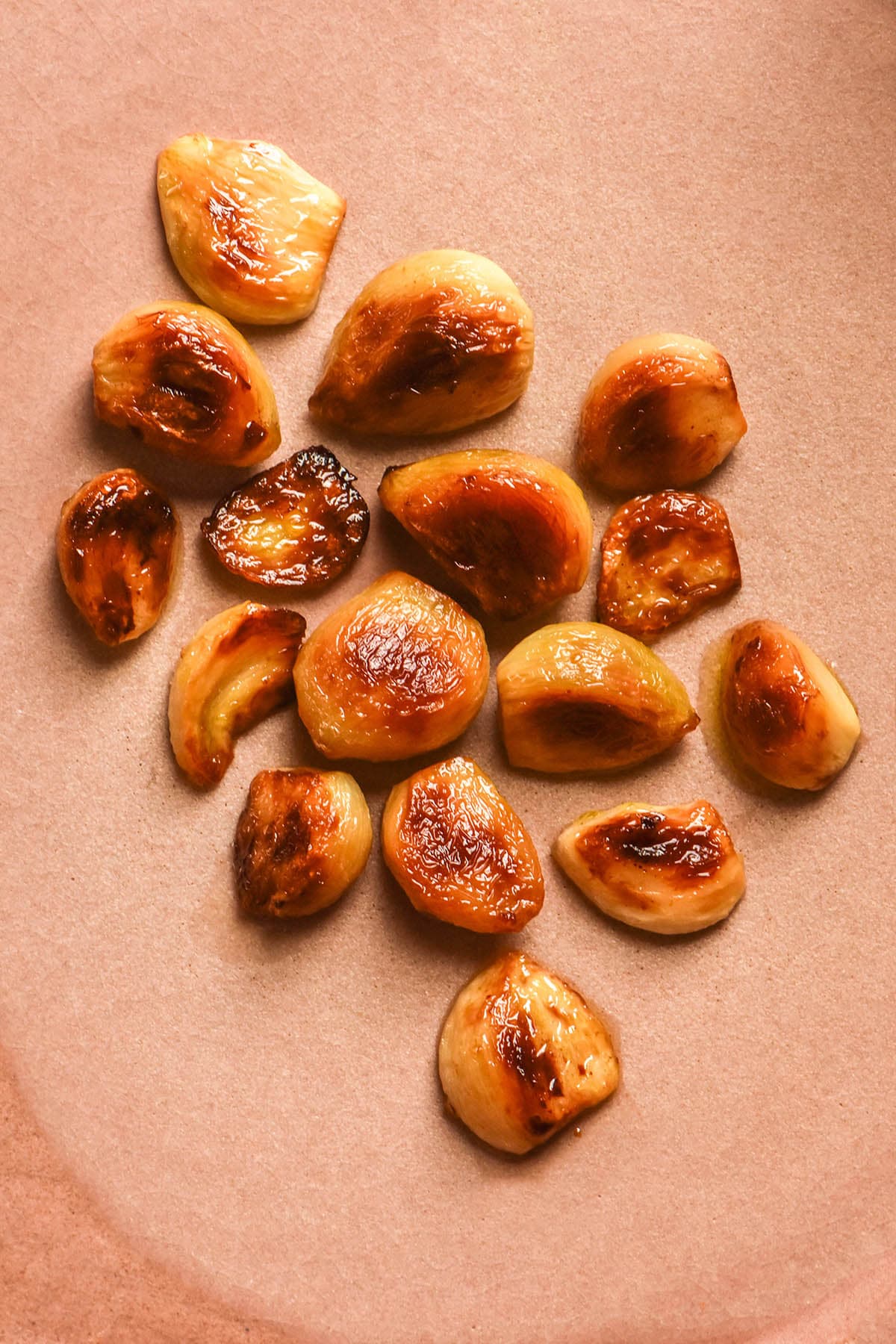
Where can I use roasted pickled garlic?
Anywhere! Everywhere! It truly is a delicious ingredient that can be added to just about any savoury dish to give it some oomph. The first things I plan to do are:
- A low FODMAP roasted garlic focaccia by adding it to my gluten free focaccia recipe
- Low FODMAP chilli oil noodles with added roasted garlic
- A low FODMAP roasted garlic pasta (or in my low FODMAP pasta)
- In my low FODMAP pasta sauce (or the low FODMAP Nomato version)
- Smeared on gluten free baguette with garlic infused ghee (double garlic heaven)
My personal favourite right now? Eating it as is. It’s such an exciting change of pace to be able to enjoy a bit of garlic without feeling terrible.
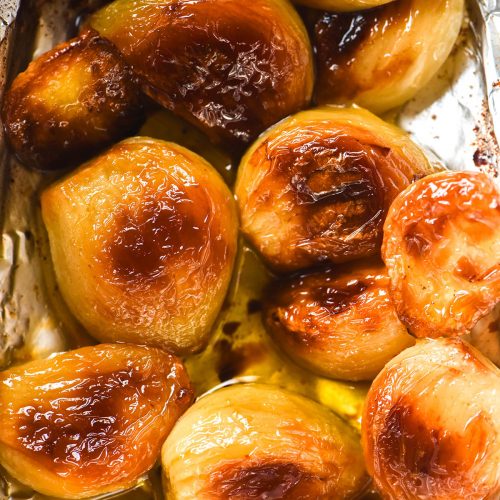
Low FODMAP roasted garlic
Ingredients
- 50g homemade pickled garlic, rinsed and dried (see notes for recipe)
- 10ml (2 tsp) olive oil
- Sprinkle of salt, to your tastes
Instructions
- Preheat the oven to 200C/400F.
- Place your rinsed pickled garlic in a medium, flat piece of foil. Drizzle the olive oil over to coat each clove. Sprinkle over a pinch of salt.
- Fold up the short sides of the foil, then the long sides. Wrapping the garlic up like a flat present means each clove gets an equal amount of heat. It's also easier to check for done-ness if you haven't just scrunched all the foil together.
- Place the package in a small baking dish to catch any escaping oil. Bake for 40 minutes then check to see if the garlic is soft and golden brown. If you want your garlic cloves to be equally browned on both sides, gently open the package (without ripping) and turn the pieces of garlic at the 20 minute mark.
- Cook until you reach your desired consistency, being careful not to burn the bottoms of the garlic pieces. They will brown considerably compared to the tops, particularly if you use a lightweight baking dish. I use a ceramic Le Creuset to help stop them from browning too much, but any sturdy dish or tray will work.
- Store leftover roasted garlic in the fridge in an airtight container and use within 2 weeks. You can also freeze and defrost leftover roasted garlic.
Notes
- This recipe is only low FODMAP if you use pickled garlic. You can find my recipe for pickled garlic here.
- I highly recommend using homemade pickled garlic for this recipe. Store bought pickled garlic has a one dimensional flavour that I would barely describe as garlic.
- Follow the food safety instructions for the pickled garlic and this roasted pickled garlic carefully. Garlic can grow botulism if not prepared carefully and botulism can be fatal.
- See the body of the post for FODMAP notes, tips and tricks.

No Comments